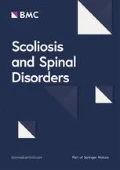Purpose of the study
The purpose of this study was to compare two different scoliosis brace designs in the treatment of a particular curve pattern.
Background
The Chêneau brace is considered one of the standards in the treatment of juvenile and adolescent idiopathic scoliosis. The RSC brace, a Chêneau derivate, uses a specific clinical and radiological classification in order to define the most effective principles of correction. (Figure 1)

Figure 1
Methods
In this case control study, 11 patients with long thoracic curves (imbalanced three-curve pattern or A1 from the Rigo classification) were treated with a specifically designed RSC brace called "three curves brace with open pelvis." These 11 patients were compared to a control group of 10 patients with the same age and curve magnitude, treated with a classical RSC brace for a three-curve scoliosis pattern. Patients with a combined upper thoracic structural curve were not included in any of the groups. The mean age was 10.5 years, mean Cobb angle was 29.5°, and mean axial rotation was 15°. The compared values were the in-brace correction of the Cobb angle and the axial rotation.
Results
The in-brace correction of the Cobb angle was 76.7% in the study group compared to 43.3% in the control group (p < .005). The in-brace correction of the axial rotation was 55.9% in the study group compared to 29.9% in the control group.
Conclusion
In-brace correction of the Cobb angle and axial rotation can be improved in patients with long thoracic curves treated with a recently described brace design ("three curves brace with open pelvis") in comparison with the classic RSC model for this curve pattern.
Author information
Authors and Affiliations
Corresponding author
Rights and permissions
Open Access This article is published under license to BioMed Central Ltd. This is an Open Access article is distributed under the terms of the Creative Commons Attribution 2.0 International License (https://creativecommons.org/licenses/by/2.0), which permits unrestricted use, distribution, and reproduction in any medium, provided the original work is properly cited.
About this article
Cite this article
Rigo, M., Gallo, D. A new RSC brace design to treat single long thoracic scoliosis. Comparison of the in-brace correction in two groups treated with the new and the classical models. Scoliosis 4 (Suppl 2), O46 (2009). https://doi.org/10.1186/1748-7161-4-S2-O46
Published:
DOI: https://doi.org/10.1186/1748-7161-4-S2-O46

